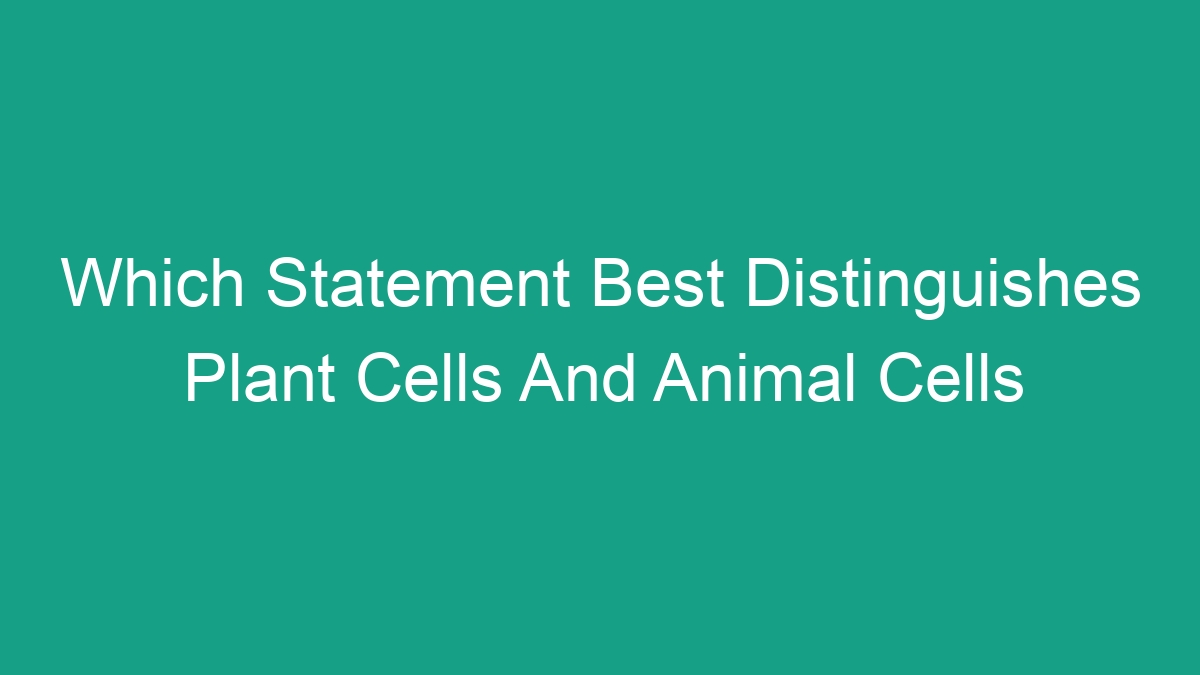
Introduction
When it comes to the study of biology, one of the fundamental concepts is the comparison between plant cells and animal cells. Although both types of cells share some similarities, they also have several distinct differences. Understanding these differences is crucial to gaining a deeper understanding of the natural world and the various organisms that inhabit it. In this article, we will explore the various characteristics that distinguish plant cells from animal cells, focusing on the statement that best encapsulates these differences.
Structural Differences
One of the key differences between plant cells and animal cells lies in their structural composition. Plant cells are characterized by the presence of a rigid cell wall, which provides structural support and protection. This cell wall is composed of cellulose, a complex polysaccharide that gives plants their characteristic rigidity. In contrast, animal cells do not have a cell wall, and their outermost layer is the cell membrane.
Another important distinction is the presence of plastids in plant cells – organelles that are responsible for processes such as photosynthesis and the storage of starch. Chloroplasts, a type of plastid, contain chlorophyll, the pigment that gives plants their green color and facilitates the process of photosynthesis. Animal cells do not contain plastids or chloroplasts.
Furthermore, plant cells typically have a large central vacuole that occupies a significant portion of the cell’s interior. This vacuole plays a crucial role in maintaining turgor pressure within the cell and storing various substances. While animal cells also have vacuoles, they are smaller and more numerous compared to the central vacuole found in plant cells.
Metabolic Differences
Metabolically, plant cells and animal cells also differ in several key aspects. As previously mentioned, plant cells possess chloroplasts, which enable them to carry out the process of photosynthesis. This process allows plants to convert light energy into chemical energy, producing glucose and oxygen as byproducts. In contrast, animal cells do not have the capacity for photosynthesis and rely on external sources of organic molecules for energy production.
Another metabolic difference lies in the storage of carbohydrates – in plant cells, excess carbohydrates are stored in the form of starch within plastids, particularly within the chloroplasts. On the other hand, animal cells store excess carbohydrates in the form of glycogen, primarily in the liver and muscle tissue.
Additionally, plant cells are capable of cell division through the process of cytokinesis, which involves the formation of a new cell wall between the two daughter cells. Animal cells, on the other hand, undergo a process known as cleavage during cell division, where the cytoplasm is divided through the formation of a cleavage furrow.
Functional Differences
In terms of functionality, plant cells and animal cells also exhibit distinct differences. The presence of a cell wall in plant cells provides structural support and protection, allowing plants to maintain their shape and resist external forces. This is in contrast to animal cells, which rely solely on the cell membrane for structural integrity.
Furthermore, the large central vacuole in plant cells serves various functions, including regulating turgor pressure, storing nutrients and waste products, and maintaining the pH balance of the cell. Animal cells, while possessing smaller vacuoles, primarily use them for the storage of cellular waste and maintaining ion concentrations.
Another important functional difference lies in the ability of plant cells to synthesize their own food through photosynthesis. This gives plants a distinct advantage in environments where sunlight is abundant, as they can harness this energy to sustain themselves. Animal cells, lacking chloroplasts and the ability to carry out photosynthesis, must obtain their energy through the consumption of other organisms or organic matter.
Response to Stimuli
When it comes to responding to external stimuli, plant cells and animal cells also exhibit different behaviors. While animal cells are capable of movement and locomotion, plant cells are generally more stationary. Instead of moving in response to stimuli, plant cells exhibit growth and development through processes such as cell elongation and division.
Moreover, plant cells have specialized structures such as roots, stems, and leaves, which allow them to better respond to environmental cues such as light, gravity, and water availability. In contrast, animal cells rely on sensory organs and nervous systems to detect and respond to external stimuli.
Reproduction
Reproduction is another area where plant cells and animal cells demonstrate differences. Plant cells are capable of reproducing asexually through processes such as budding, fragmentation, and vegetative propagation. In addition to asexual reproduction, plant cells can also reproduce sexually through the formation of seeds and spores.
On the other hand, animal cells reproduce exclusively through sexual reproduction, which involves the fusion of gametes from two parents to produce offspring. This fundamental difference in reproductive strategies underscores the distinct evolutionary paths taken by plants and animals.
Conclusion
In conclusion, the statement that best distinguishes plant cells and animal cells is the recognition of their structural, metabolic, functional, and behavioral differences. These disparities are rooted in the unique evolutionary trajectories of plants and animals, which have led to the development of specialized cellular features and processes. By understanding these differences, scientists are better equipped to appreciate the diversity of life on Earth and the intricate ways in which organisms have adapted to their respective environments. Moving forward, continued research into plant and animal cell biology will yield valuable insights into the fundamental principles that govern life itself.



